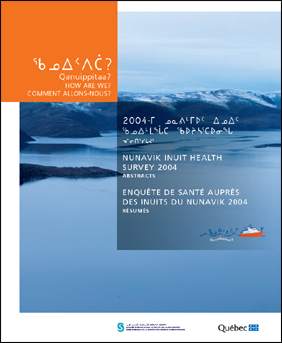
The Inuit communities of Nunavik have experienced profound change in every aspect of their lives over the last few decades. As contact with more southerly regions increased, the Inuit changed their living habits, adopting a more sedentary lifestyle, modern living conditions and new eating habits. The survey conducted by Santé Québec in 1992 demonstrated that these changes had an impact on the health status of this population. Ten years later, the Nunavik Regional Board of Health and Social Services (NRBHSS) deemed it important to make plans for a new survey in its region to monitor the evolution of the health status and state of well-being of its population.
Thanks to the collaboration of a number of professionals from the health network and the university milieu, 17 theme papers, a nutrition report, and a methodological report were produced in the context of the survey. The information gathered enabled a profile to be compiled of the health status and state of well-being of the Nunavik Inuit at a specific moment in time; it also provided data on a number of health determinants.
The Nunavik Inuit Health Survey 2004 could not have been undertaken without the financial support of the Ministère de la Santé et des Services sociaux du Québec (MSSS), the Nunavik Regional Board of Health and Social Services (NRBHSS), the Indian and Northern Affairs Canada (INAC), the Canadian Foundation for Innovation (CFI), the Network of Centres of Excellence of Canada (ArcticNet), the Nasivvik ACADRE Inuit Centre and the Canadian Institutes of Health Research (CIHR). The valuable assistance of Inuit representatives – both members of the survey advisory committee and Inuit leaders from each community – is gratefully acknowledged. Our gratitude is also extended to the staff of the Canadian Coast Guard Ship Amundsen and to all the professionals, technicians, students, interviewers and clerical staff who worked at each stage of the survey process. Finally, we wish to thank the Inuit people of Nunavik for their extensive cooperation with this survey.
Alcohol, Drug Use and Gambling Among the Inuit of Nunavik: Epidemiological Profile, 641 Ko
Epidemiological Portrait of Physical Violence and Property Offences in Nunavik, 581 Ko
Exposure to Environmental Contaminants in Nunavik: Metals, 661 Ko
Les faits saillants de l’enquête, 412 Ko
- English : Survey Highlights, 583 Ko
Hearing Loss and Dental Health, 600 Ko
Iron Deficiency and Anemia among Women in Nunavik, 661 Ko
Mental Health, Social Support and Community Wellness, 664 Ko
Methodological Report, 8,78 Mo
Nutrition and food consumption among the Inuit of Nunavik, 4,26 Mo
Physical Activity, Anthropometry and Perception of Body Weight, 647 Ko
Prevalence and Nature of Sexual Violence in Nunavik, 569 Ko
Socio-demographic Portrait, 545 Ko
Status of Cardiovascular Disease and Diabetes in Nunavik, 618 Ko
Tobacco Use, 553 Ko
Transportation Injuries and Safety, 585 Ko
Women’s Health and Preventive Sexual Behaviour among Men and Women, 551 Ko
Zoonotic Diseases, Drinking Water and Gastroenteritis in Nunavik: A Brief Portrait, 684 Ko

